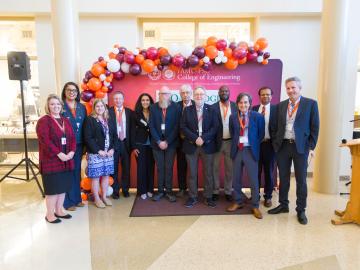
Filter News
Area of Research
- Advanced Manufacturing (3)
- Biology and Environment (13)
- Clean Energy (22)
- Computational Biology (1)
- Computational Engineering (2)
- Computer Science (5)
- Fuel Cycle Science and Technology (1)
- Fusion and Fission (11)
- Fusion Energy (6)
- Isotope Development and Production (1)
- Isotopes (4)
- Materials (34)
- Materials for Computing (6)
- National Security (13)
- Neutron Science (66)
- Nuclear Science and Technology (20)
- Nuclear Systems Modeling, Simulation and Validation (1)
- Sensors and Controls (1)
- Supercomputing (29)
News Type
News Topics
- (-) Artificial Intelligence (49)
- (-) Biomedical (28)
- (-) Neutron Science (79)
- (-) Nuclear Energy (46)
- (-) Security (13)
- (-) Statistics (2)
- 3-D Printing/Advanced Manufacturing (78)
- Advanced Reactors (24)
- Big Data (24)
- Bioenergy (39)
- Biology (40)
- Biotechnology (11)
- Buildings (35)
- Chemical Sciences (43)
- Clean Water (15)
- Climate Change (46)
- Composites (20)
- Computer Science (101)
- Coronavirus (28)
- Critical Materials (23)
- Cybersecurity (20)
- Decarbonization (32)
- Education (3)
- Element Discovery (1)
- Energy Storage (74)
- Environment (81)
- Exascale Computing (11)
- Fossil Energy (2)
- Frontier (16)
- Fusion (26)
- Grid (37)
- High-Performance Computing (41)
- Hydropower (6)
- Irradiation (2)
- Isotopes (23)
- ITER (5)
- Machine Learning (25)
- Materials (96)
- Materials Science (87)
- Mathematics (2)
- Mercury (5)
- Microelectronics (1)
- Microscopy (27)
- Molten Salt (8)
- Nanotechnology (38)
- National Security (21)
- Net Zero (5)
- Partnerships (30)
- Physics (28)
- Polymers (21)
- Quantum Computing (15)
- Quantum Science (38)
- Renewable Energy (1)
- Simulation (16)
- Space Exploration (13)
- Summit (27)
- Sustainable Energy (75)
- Transformational Challenge Reactor (4)
- Transportation (61)
Media Contacts

The Department of Energy announced a $67 million investment in several AI projects from institutions in both government and academia as part of its AI for Science initiative. Six ORNL-led (or co-led) projects received funding.

Oak Ridge National Laboratory has launched its Neutron Nexus pilot program with Florida Agricultural & Mechanical University and Florida State University through the FAMU-FSU College of Engineering. The first program of its kind nationwide, it’s aimed at broadening and diversifying the scientific user community with outreach to universities and colleges.

A study led by the Department of Energy’s Oak Ridge National Laboratory details how artificial intelligence researchers created an AI model to help identify new alloys used as shielding for housing fusion applications components in a nuclear reactor. The findings mark a major step towards improving nuclear fusion facilities.

U2opia Technology has licensed Situ and Heartbeat, a package of technologies from the Department of Energy’s Oak Ridge National Laboratory that offer a new method for advanced cybersecurity monitoring in real time.

In a game-changing study, ORNL scientists developed a deep learning model — a type of artificial intelligence that mimics human brain function — to analyze high-speed videos of plasma plumes during a process called pulsed laser deposition.

ORNL’s Matthew Loyd will receive a Department of Energy Office of Science Early Career Research award.

A team led by scientists at ORNL identified and demonstrated a method to process a plant-based material called nanocellulose that reduced energy needs by a whopping 21%, using simulations on the lab’s supercomputers and follow-on analysis.

Researchers for the first time documented the specific chemistry dynamics and structure of high-temperature liquid uranium trichloride salt, a potential nuclear fuel source for next-generation reactors.

DOE commissioned a neutron imaging instrument, VENUS, at the Spallation Neutron Source in July. VENUS instrument scientists will use AI to deliver 3D models to researchers in half the time it typically takes.

Prasanna Balaprakash, director of AI programs at the Department of Energy’s Oak Ridge National Laboratory, has been appointed to Tennessee’s Artificial Intelligence Advisory Council.


